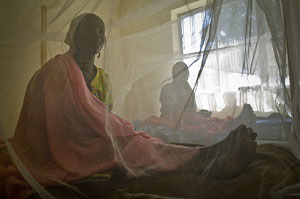
Introduction:
There are an extremely wide range of factors that influence whether or not a woman seeks and obtains quality care from modern health-care facilities. The obstacles that women face are much "more than a problem of distance" and a lack of financial resources to cover the cost of care and transportation (although these are certainly important factors). Literature in this area tends to distinguish between "access to care" and "quality of care." Quality-of-care research usually centers on the experiences of those who have managed to gain access to modern health services, but the individuals who choose not to use services, or who are unable to do so, are not addressed. However, female clients may consider access to care to be integrally linked to quality of care; conversely, services considered to be of poor quality will not be used. Therefore, barriers that influence whether or not a woman is able to gain access to services will be addressed, as will factors that influence the quality of care provided to women at the point of service delivery.
Recognition of illness
Before a woman decides to seek care, she must be able to recognize the signs and symptoms that indicate the need for care. However, a lack of educational opportunities and poor understanding of health-related matters mean that many women are not familiar with different diseases and their presentation. For example, some women assume that "vaginal discharge is a natural part of being a woman" or think that back pain is normal because they have suffered from it for as long as they can remember. How many girls and women in the world still suffer from poverty of education, information, and knowledge?
As a result of cultural restrictions and taboos, women may be unable to interpret signs of illness, particularly as they relate to the genitals.
Competing demands
 Even if a woman notices symptoms of illness, she may completely ignore these signs because of other competing demands. Women may believe that they cannot afford the "luxury" to take time out to visit a health centre or to have a period of incapacity because this would represent time and effort lost to other essential and possibly more important, activities such as child care, food production, and paid employment. Generally, mothers say that they are busy, that they are not able to come [to the health centre], that they have to travel or that they are traders. They also say that their business nourishes the whole family and they cannot neglect all the children just for one.
Even if a woman notices symptoms of illness, she may completely ignore these signs because of other competing demands. Women may believe that they cannot afford the "luxury" to take time out to visit a health centre or to have a period of incapacity because this would represent time and effort lost to other essential and possibly more important, activities such as child care, food production, and paid employment. Generally, mothers say that they are busy, that they are not able to come [to the health centre], that they have to travel or that they are traders. They also say that their business nourishes the whole family and they cannot neglect all the children just for one.
The hours when health clinics are open may not be sensitive to the gender division of labour and the timing of women's work. Women's work patterns should therefore be considered when setting clinic hours. To increase the chances of working women receiving care, health services might also be established where women work, such as at factories. Other family or community members rarely assume women's essential tasks when they are ill. Women therefore continue to perform necessary activities that are difficult to defer. Because women do not take off enough time to care for their health, it usually takes them longer to fully recover from illness or disease. The amount of time that a woman stays in hospital (if she has to go) can be significantly shorter than the amount of time taken by a man, and a woman invariably returns to her work, both inside and outside the home, before she is fully recovered.
Women's health is not a priority
Women in developing countries tend to place the health and well-being of their families, especially children, as a priority over their own health and, consequently, do not seek medical care for themselves. Furthermore, male children tend to be given superior access to care compared with female children. The general low status of women, and their internalization of this status, results in the marginalization of women's physical, psychological, and emotional needs. Women are less likely than men to consult modern health services, wait longer than men to seek treatment when ill, are reluctant to spend limited resources on their own needs, and often cope with illness by self-treatment, by consulting traditional healers, or by simply living with the condition and its resulting discomfort Because of their heavy household duties, women cannot afford to be sick themselves. It would be useful to discover how many ailments exist among women but never receive attention from the medical profession.
Women need to be broadly educated about the importance of regular health care for themselves, as well as for their children. The role of self-esteem, an important factor that affects whether or not women seek care for their own health, should be considered when educational health programs are implemented. Because women tend to place great importance on their children, it may be useful to present messages that instill the notion that it is important that a woman be healthy to maintain her child's health.
Lack of support
Social support from others, such as relatives, friends, and neighbors can play an important role in fostering the physical and psychological health of and can greatly influence the health-seeking behavior of women. Less importance may be placed on the health of female members of the household, compared with male members, and, consequently, a woman's illness may receive little attention from others. Although men are strongly pressured by other family members, particularly from mothers and wives, to seek treatment, women are unlikely to receive such encouragement -- "a woman's role is to nurse, not to be nursed."
The true extent of some women's health problems may be completely underestimated by society. Because some very serious illnesses and conditions may not be properly acknowledged by society for example, cancer, AIDS, physical disabilities, chronic fatigue, and depression, women with such problems may not be assigned "a legitimate sick status." If a woman's illness is not identified as being authentic, it is doubtful that she will receive support from family members and the wider community to seek care.
Shame and embarrassment
 Shame and embarrassment can lead to reluctance on the part of women to share disease conditions with family members and health and this may prevent them from reporting to health services for the diagnosis and treatment of illnesses. A reluctance to tell others is particularly acute in the case of illnesses with genital or urinary involvement. There is considerable stigma associated with STDs because these diseases are associated with sexual deviance. It is not surprising that women are very concerned about the consequences of detection and the possibility of being ostracized by their family and community. Women who have been victims of violence and abuse may be very unwilling to seek medical care because they are reluctant to draw attention to their situation.
Shame and embarrassment can lead to reluctance on the part of women to share disease conditions with family members and health and this may prevent them from reporting to health services for the diagnosis and treatment of illnesses. A reluctance to tell others is particularly acute in the case of illnesses with genital or urinary involvement. There is considerable stigma associated with STDs because these diseases are associated with sexual deviance. It is not surprising that women are very concerned about the consequences of detection and the possibility of being ostracized by their family and community. Women who have been victims of violence and abuse may be very unwilling to seek medical care because they are reluctant to draw attention to their situation.
Fear of illness
Some women express concern that diseases would be discovered during check-ups and they said "they would rather not know [about them]." Woman may be concerned that she might have "cancer of the uterus" and she would "rather not know" because her "mother-in-law died of cancer of the uterus" and her "sister-in-law left behind five children, she died of cancer of the uterus." The inclusion of blood tests in regular check-ups may lead to similar concerns.
Apathy and depression
Women who suffer from psychological conditions, such as depression, may have a complete sense of apathy toward their own health care. Although psychological conditions often have a biological component, the particularly harsh living conditions of many women, including poverty, high stress, isolation, and an absence of social support, may work together to produce a state of depression or apathy. The inability of some women to express their problems may adversely affect their psychological health. For other women, childhood experiences of violence, including rape or incest, may be factors related to their apathy or depression.
Access to health facilities
 People should be able to receive reliable care close to where they live. However, health facilities are often poorly distributed, and health personnel and financial resources tend to be concentrated in urban hospitals. In rural areas where the vast majority of women in the developing world live, are less likely to have adequate health services. Difficulties in reaching health facilities, as a result of distances, lack of transportation, or poor roads, are well-documented impediments to care. In rural areas, the common mode of transportation for women is walking (or occasionally a bicycle or a bullock-cart). If an ill woman wants to visit a health centre, she may have to walk very long distances. If her child is ill, she may have to walk several kilometers with the sick child strapped on her back. These long distances often mean that women only visit clinics when their health, or the health of their child, has reached a critical stage. Clients who are farther away are less likely to have a good understanding or an exposure to the services provided by the facility. Greater familiarity can bring with it higher levels of acceptability.
People should be able to receive reliable care close to where they live. However, health facilities are often poorly distributed, and health personnel and financial resources tend to be concentrated in urban hospitals. In rural areas where the vast majority of women in the developing world live, are less likely to have adequate health services. Difficulties in reaching health facilities, as a result of distances, lack of transportation, or poor roads, are well-documented impediments to care. In rural areas, the common mode of transportation for women is walking (or occasionally a bicycle or a bullock-cart). If an ill woman wants to visit a health centre, she may have to walk very long distances. If her child is ill, she may have to walk several kilometers with the sick child strapped on her back. These long distances often mean that women only visit clinics when their health, or the health of their child, has reached a critical stage. Clients who are farther away are less likely to have a good understanding or an exposure to the services provided by the facility. Greater familiarity can bring with it higher levels of acceptability.
Restrictions on mobility
Cultural norms that restrict the movements of women in some societies can prevent women from consulting health services. In rural areas of India and Pakistan, for example, females are not allowed to travel long distances alone. A male member of the family, even the youngest brother or son, is required to accompany a woman. This limits the distance women can travel alone to seek health care. To get around this barrier to care, it has been suggested that "elderly widows of secure honour and status might be trained as health workers to visit women in domestic seclusion." A woman-centered strategy would require additional measures such as encouraging female community nurses to visit homes, especially those in communities where women are in seclusion, for case detection and management as part of the program to control malaria.
Access to financial resources
Lack of access to resources to cover transport, service, and treatment costs is another barrier to care. Women generally lack control of financial resources (often scarce) and therefore cannot, or will not, divert them for their own health. Given the limitations on women's earnings in both formal and informal employment, and their complete exclusion from the cash economy in some cases, the extent to which poor women, particularly those who head households, can afford expenditures [associated with health care] is questionable. Because they are financially dependent on husbands or relatives women rely on male household members to pay the costs associated with health services. Men usually have the ultimate financial decision-making power about whether or not a family member can go to a health.
Sex and maturity of the health worker
In many poor countries, the primary health-care worker is male. The lack of female health-care providers is another deterrent that prevents women from reporting to health services, particularly for illnesses involving the genitals and those causing physical deformities. When female clients do see male providers, shyness and reservation, especially concerning sexual health matters, can make it nearly impossible to establish a good client provider relationship.
Culturally sensitive services
Health care for women must be culturally acceptable; otherwise women may underutilize existing health services. It has been discovered that there are many differences between the traditional and western systems in their practices and beliefs related to prenatal care, labour, and delivery. Indigenous women are reluctant to attend hospitals for deliveries because of drawbacks inherent in the modern health-care system. Indigenous women preferred to deliver their babies at home because they could take local help in labour, they could be attended by their relatives and husband, they could walk around, they could be wrapped up warmly and wear their own clothes, they were not shaved or cut, and they were able to deliver vertically, squatting on their haunches. At the western-based hospital, however, nothing could be consumed, they were attended by strangers, they could not walk around during labour, they were undressed and given a hospital gown, the hospital was cold, an episiotomy was mandatory, and they had to deliver horizontally in the gynecological position.
Medical and hospital practices should ensure that they are culturally acceptable to the people who are intended to use them. Health services should adapt their working methods to accommodate traditional practices that are not detrimental to women's health. Although cultural norms and values must be respected, at some point it may be necessary for the health sector to challenge beliefs and practices that are harmful to women's health.
Poor quality of care
 Women's decisions to seek care are influenced by their judgments about the nature and quality of health services. If women lack confidence in the available services, they generally do not use them. Women are often reluctant to use local health services because they believe, often correctly, that these services are poor. As a result, tertiary-level facilities are often seriously overcrowded because women consider them to be more effective and seek them out, despite the distances. Many women have had poor personal experiences with health services, and their health is compromised by their reluctance to return to such services. Women's health-seeking behavior is also influenced by negative stories relayed to them by relatives and neighbors about the care they received. Women with positive attitudes to the staff at the health centre were almost three times more likely to deliver their children with the assistance of a trained person compared with those with negative attitudes. Certain sources of information, such as friends and relatives, can be particularly credible to women who were making health-related decisions. Women commonly complain that they are not provided with sufficient information. It is generally believed that female clients place great emphasis on interpersonal relationships. Research findings, however, have highlighted a general lack of sensitivity on the part of providers in their dealings with clients. The doctor should not scold one for taking the child [who is] dirty because if she goes for an emergency, she's not going to be thinking that she should wash him beforehand.
Women's decisions to seek care are influenced by their judgments about the nature and quality of health services. If women lack confidence in the available services, they generally do not use them. Women are often reluctant to use local health services because they believe, often correctly, that these services are poor. As a result, tertiary-level facilities are often seriously overcrowded because women consider them to be more effective and seek them out, despite the distances. Many women have had poor personal experiences with health services, and their health is compromised by their reluctance to return to such services. Women's health-seeking behavior is also influenced by negative stories relayed to them by relatives and neighbors about the care they received. Women with positive attitudes to the staff at the health centre were almost three times more likely to deliver their children with the assistance of a trained person compared with those with negative attitudes. Certain sources of information, such as friends and relatives, can be particularly credible to women who were making health-related decisions. Women commonly complain that they are not provided with sufficient information. It is generally believed that female clients place great emphasis on interpersonal relationships. Research findings, however, have highlighted a general lack of sensitivity on the part of providers in their dealings with clients. The doctor should not scold one for taking the child [who is] dirty because if she goes for an emergency, she's not going to be thinking that she should wash him beforehand.
Health workers who are from the same community as the people being served may have better success and provide better care than those from outside the community because they share a common cultural background and common experiences. Likewise, those who totally immerse themselves in a community may gain the trust and respect of the people being served -- crucial elements to good health care.
Good interpersonal care requires sufficient time on the part of the provider. Many physicians, however, reportedly do not provide enough time to let women talk about how or what they feel. Women should have the opportunity to discuss various psychosocial factors related to their health and well-being. In this way, they can learn about the relationship between the illness and disease and their lives as women, workers, mothers, and wives.
School curricula, including medical and health education curricula, must address gender issues and the specific health needs of women. The basic training and refresher training courses of all health providers need reorientation to place health in the context of unequal gender status, and to provide women's perspectives on their needs and experiences.
Women are frustrated and discouraged when they travel great distances to the health centre by foot only to discover that the health worker is not there or that there is only one person available who has to treat many, and is therefore unable to provide adequate service and attention to individual clients. Time of access for clients at some health facilities may be limited to only a fraction of the official 8 hours. Because health-care providers often receive little compensation for their work in public clinics, they may spend part of the working day at a private clinic to make extra money. Providers in developing countries usually face numerous constraints that affect the quality of care they are able to provide. They tend to be overworked and underpaid, and health centers are invariably understaffed and underfinanced. As a result, they complain of having neither the time nor the energy to provide long explanations and high-quality care to their clients.
Ensuring the availability of essential supplies, equipment, and medication is a necessary requirement for good quality health care. However, there are often serious deficiencies in this. The lack of integration of health services is another key factor that influences women's health-seeking behavior and the quality of care received. In many countries, different types of health services (such as prenatal care, family planning, immunizations) are not integrated, and they may even be offered on different days. Women are therefore forced to return repeatedly to a clinic to receive care for their various health needs as well as the needs of their children. Given the heavy workloads and limited personal time available to women, strategies aimed at combining several health services at convenient times to meet women's needs should to be fully.



